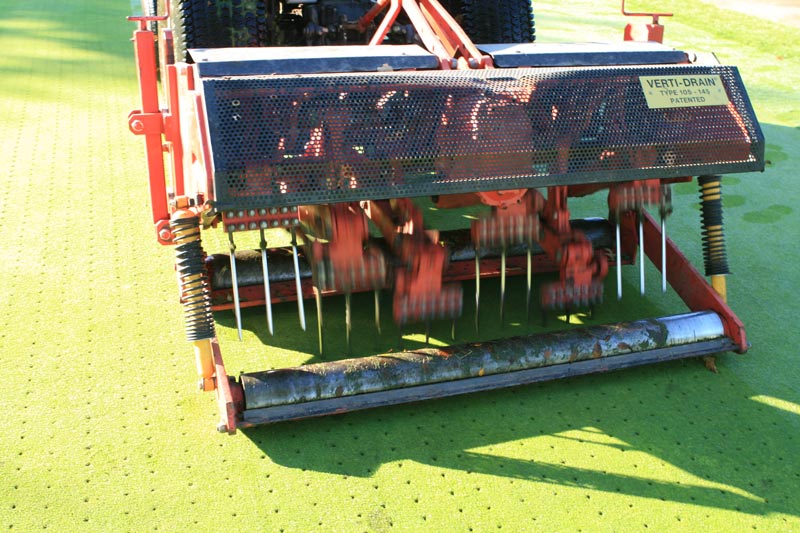
Part art, part science, part personal preference, effective aerification hinges on the proper interplay of several variables, some within and some outside of the superintendent’s control. Photo courtesy of Dan Dinelli
It seems a simple, straightforward question, in the tradition of chocolate or vanilla, boxers or briefs, iPhone vs. Android: When it comes to aerification, do superintendents these days rely more on solid tines or hollow tines?
However, as is the case with so many agronomic issues, it’s not so much that answers differ according to climate, soil type or even personal preference. It’s that we might be posing the wrong question altogether.
Brian Hampson is the GCSAA Class A vice president of science and agronomy with Troon Golf Management, which oversees maintenance at more than 400 courses here and abroad. He can imagine scenarios where solid tines make more sense than hollow, and vice versa. But for him, it’s more a question of whether greens are being topdressed frequently enough, and if overall cultural maintenance is geared toward managing excess thatch accumulation. At more than 90% of the courses he sees — inside the Troon portfolio and otherwise — it’s clear to Hampson that’s not taking place. And he has well-wrought historical explanations for why that is.
“When I first learned how to manage USGA greens in the ’90s, this was front and center: Good irrigation practices were how we managed gas exchange in greens,” says Hampson, a 22-year GCSAA member. “That meant deep and infrequent watering, where we wet the entire profile and pushed water down through the root zone to alleviate trapped gases in the drain tile while pulling clean air down into the root zone. A truly deep cycle of water would exchange gas within the entire putting green root zone and drain tile.
“If you think back to the late ’90s and early 2000s, there was so much new course construction activity, we had tons of people working with relatively new USGA greens that performed well, because they were young and free of excess thatch and organic matter. Thatch management was not as much of a concern, and we were able to move water through greens easily.
“Today, we all have 20-year-old greens, and most courses I see have excess thatch and organic matter in the top 4 inches of the profile,” Hampson says. “We’ve worked closely with ISTRC (the International Sports Turf Research Center) to quantify organic levels and air porosity. They do very detailed physical analyses that look at each inch of the profile, and largely what they find is unhealthy levels of organic matter and low levels of air porosity. This has led us to be more deliberate with aerification practices and getting back to good topdressing habits.”
Topdressing and aerification: Back to basics
Stage II of this historical perspective takes us to 2008, when the bottom fell out of so many businesses, golf included. As courses struggled with revenues and budgets shrank, topdressing was further de-emphasized — not solely because it cost money, but because it potentially upset golfing customers and eroded revenues. In other words, Hampson sees a lack of suitable topdressing over this time as yet another example of deferred maintenance.
Today, he thinks it’s time the industry returned to more vigorous topdressing practices, using whatever tines make the most sense according to one’s specific soil conditions.
“I feel like we’ve done a poor job of topdressing as an industry, which has created a lot of the underlying thatch issues we deal with today,” Hampson says. “Twice annually used to be the rule for aeration, and the economics for the last decade might have meant reducing that to once (annually) or reducing tine size (to better accommodate play). That reduction in aerification practices combined with a reduction of topdressing has led to the excess thatch and organic matter that we struggle with today.
“The reality is, I can out-topdress a poor aerification program, but I can’t out-aerify a poor topdressing program. If I am on a light and frequent topdressing program every seven to 14 days through the growing season, I am going to manage thatch to an acceptable level on that green. The two practices go hand in hand.”
‘There are a lot of levers to pull on’
Stage III of Hampson’s analysis brings us fully up to the present day.
“If you ask younger superintendents about gas exchange, I don’t think they’re thinking about that on a day-to-day basis,” he says. “For me, the primary tool for managing gas exchange on a USGA green is good water management. It’s a different story on push-up greens for obvious reasons, but on USGA greens, it’s important to manage a true deep and infrequent watering strategy.
“When I interview young people today, I ask them why we topdress. Some say, ‘It smooths out the surface,’ or, ‘It helps move water through the profile.’ While those points may be true, they’re just ancillary benefits. The primary reason we topdress is to dilute thatch, and the importance of that function is sometimes overlooked.”
Aerification with hollow tines physically removes thatch, and Hampson sees that as the primary reason to aerify greens, as compaction is not so much of an issue with venting and other practices taking place.
“When I talk about managing organic accumulation on greens, there are a lot of levers to pull on — fertilization, watering, cultural practices. Depending on how I pull on those levers, I get very different results,” Hampson says. “I think a holistic approach that relies on good technical agronomy programming to manage long-term health is important. We can have intelligent conversations with members, guests and owners about the importance of balancing disruptive maintenance with doing what it takes to manage good greens.
“Outside of water management, topdressing may impact overall green quality more than anything else. It’s easy to overwater or overfertilize a green. It’s nearly impossible to over-topdress greens, within reason. It’s a straight-line equation for me: The more I can topdress, the better the greens will play and perform.”
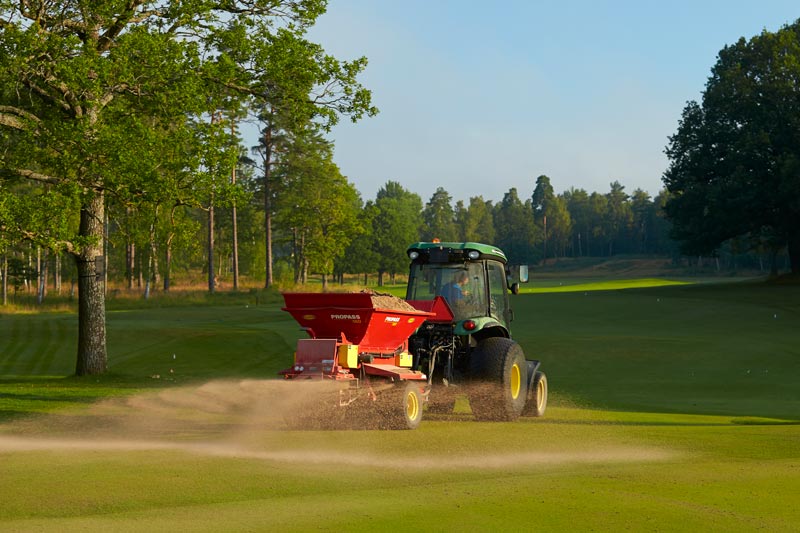
Regular topdressing programs that help manage thatch buildup — especially on older playing surfaces — are as crucial to good turf health as aerification is, says Brian Hampson of Troon Golf Management. Photo by Paul Severn
While Hampson is responsible for dozens of courses in cool, warm and transition regions, he is based in Scottsdale, Ariz. And if you pin him down on tine usage in that region, he advocates needle tines through the winter months, when overseeded greens are less prone to taking water. In other words, the solid tines make sense as a means for better water infiltration and gas exchange.
The rest of the year, as thatch is so universal, it’s hollow tines to remove organic matter, in concert with dedicated, light and frequent topdressing. Hampson points out that with twice-annual applications with 5⁄8-inch hollow tines on 1½-inch centers, one can expect to physically remove 26% of a green surface — and 26% of a thatch layer.
“We see that as a standard baseline for good thatch management,” Hampson says. “If you have a more serious problem, add a third application of some variety, or run a pedestrian-type verticutter to further remove material.”
A solid foundation at North Shore Country Club
When it comes to tine choice, topdressing frequency, thatch control or any agronomic practice, the debate ultimately centers on what is trying to be achieved versus the specific conditions of a course site. Dan Dinelli, CGCS, has been tending to North Shore Country Club outside Chicago for nearly 30 years. Three decades of diligence has his soil structure pretty much where he wants it in terms of thatch and mat. On fairways, he’s in the habit of aerifying with solid, deep tines, then topdressing with mature, quality compost during the off-season. This program cultivates the soil and manages the thatch.
But on his putting surfaces, the 37-year GCSAA member has switched over to solid tines exclusively, with little to no topdressing on his newer, sand-based USGA greens, to avoid building a topdressing horizon. Dinelli has found that topdressing builds a layer that can easily be 4 inches thick in 20 years, having “a higher percentage of organic matter and finer sand-particle size compared to the sand mix used in construction,” he says. “This imbalance creates a topdressing horizon that traps water and nutrients, creating a soft, wet surface.” Thatch is managed, he says, mostly by removal via verticutting, brushing and other cultural practices.
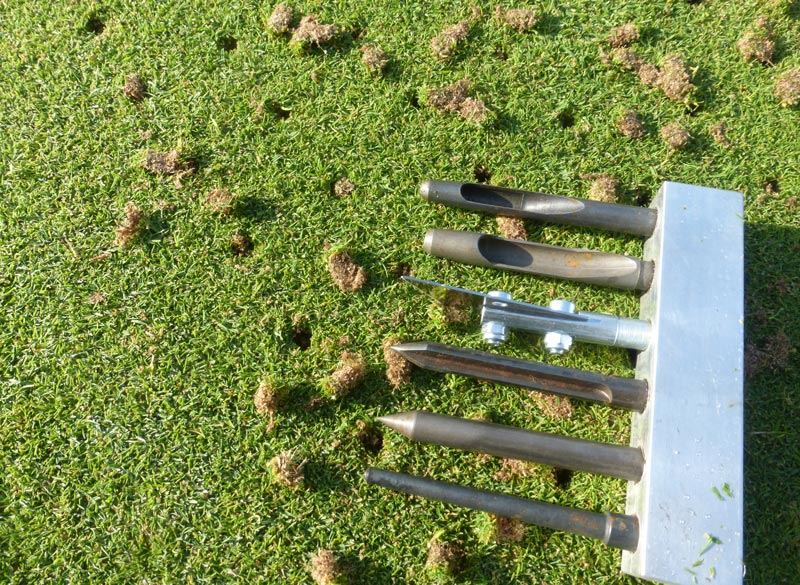
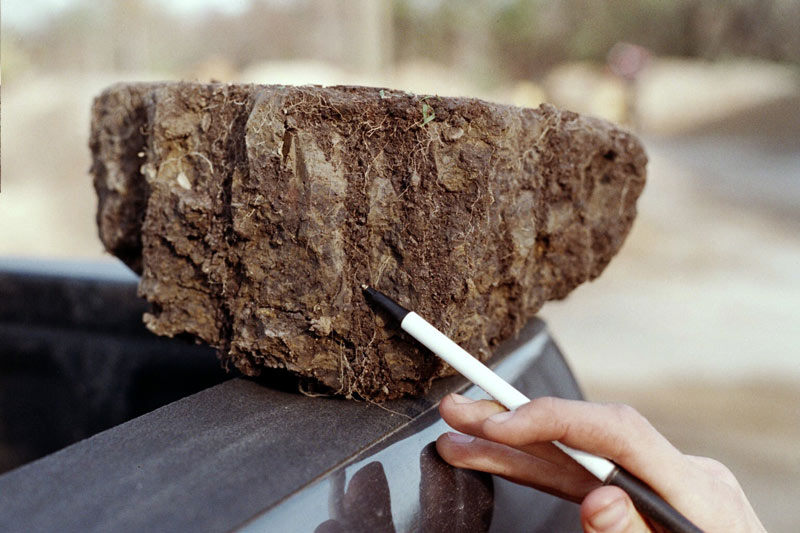
At North Shore Country Club in the Chicago suburb of Glenview, Ill., Dan Dinelli, CGCS, has tested a variety of ways of venting playing surfaces throughout his nearly three decades of overseeing course maintenance. Photos courtesy of Dan Dinelli
“What changed my mind on all this was, about 20 years ago, we spent two years researching soil gases,” Dinelli explains. “I had a sophisticated analyzer that told me what oxygen, CO2 and methane was in the ground at 2- to 3-inch depths. We experimented with solid tines, hollow tines and a HydroJect (which blasts a hole in the ground using high water pressure, leaving a barely visible hole). Every day, we analyzed what the gas was in the soil following each of these practices. It was amazing how similar they all were on the effect on soil gases. It sort of blew us away, learning they all impacted soil gases about the same, lasting a little over a week.
“My gut reaction was, the visible hole wasn’t really necessary to get good gas exchange. Outside of open holes helping with water infiltration (which impacts soil gases favorably), what it boils down to is, you’ve got to move soil particles around to ‘burp’ the pore space.”
Dinelli is referring to the kick provided by solid-tine aerification, the mechanized spasm of tines fully embedded in the soil. That kick creates the space.
“If that space in between particles gets burped, it collapses and re-expands, pushing old gases out and new gases in,” Dinelli says. “So that was my first move toward solid-tine more often. And, of course, there is no ball roll disturbance. And it costs less because there is no core removal.”
Tines: To each their own
Dinelli is cognizant that hollow-tine aeration is more common where thatch and excess mat are present. Down South, where bermudagrasses grow 12 months a year, creating organic matter all the while, hollow tines are a no-brainer. But this cultivation practice must be balanced up North with the threat of Poa annua, itself a prolific thatch producer.
“At an old golf course like mine, there’s a lot of Poa seed in my soil, on account of all those years of deposited seed from the plant,” Dinelli says. “When I core-aerify, I am bringing that Poa seed back up near the surface to potentially germinate and grow. You should have seen the Poa come in on the old greens — like rows of corn. If you had enough rain and temps were right, that Poa came in those open holes pretty aggressively, almost like I was overseeding with Poa annua. When you go to a solid tine, you cultivate the ground like you want to, when you need to, with holes that close too fast for Poa to invade.”
Visit North Shore Country Club and hear from Dan Dinelli, CGCS, about the golf course’s recent greens renovation:
Dinelli has moved to solid-/deep-tining his fairways twice a season. Greens get monthly solid-needle-tine treatments as well. On his old collars, he still pulls cores to try to reduce the “speed bump” effect, which results from too much topdressing-sand buildup in this slightly taller turf cut. “On tees, I also still pull cores because we rebuilt the tees using a sandy mix and sodded with bent,” he says. “I felt coring the tees was still of value while working out the sod layer.
“If I went to a new course with different layers of sands and consistencies, I’d be pulling a ton of cores. It depends on your situation, what you’re trying to achieve. But for ongoing aerification and burping, solid tines make sense here. Less disruption, less money, less Poa.”
Turf systems are active in this sense — the biology of soil microbes and root systems consumes a great deal of oxygen, in turn creating a great deal of CO2. Soil gases become tainted — what Hampson calls “sewer gases” — far more quickly when profiles become compacted or waterlogged. This is part of what makes sand so attractive: It doesn’t compact easily, and it drains well. A USGA root zone effectively expels old water and gases, allowing for the influx of clean water and oxygen.
One of the findings that made such an impression on Dinelli was how quickly solid-tine holes closed near the surface (they lose 50% of their diameter almost immediately) and how viably they promoted this influx of oxygen.
“When it comes to analyzing soil gases, the tools are expensive and tricky to use. So we generalize a lot,” he says. “But what we found, under warm, moist soil conditions where microbial activity is high, all those practices last about two weeks. Whether you punch with solid, core-aerify with hollow tines or blast the water down there, you get two weeks of impact. But after that, soil gases are back to where they were. As soils cool down, this will slow that process down. Fewer rain events? That slows it down, because that water pushes the gases out. So every four weeks makes sense for us — every four weeks with needle tines all summer long.”
Unleashing the ninja (tines) in South Florida
Kenyon Kyle, CGCS, is the superintendent at Audubon Country Club in Naples, Fla., where he fights a never-ending battle to dilute an organic layer born of ceaseless growing seasons. Core aeration is a given in summer, but water percolation and air exchange in winter months — high season in Florida — require a more nuanced approach. This is one reason he experimented this year with so-called ninja tines — needle-sized tines that are nevertheless hollow.
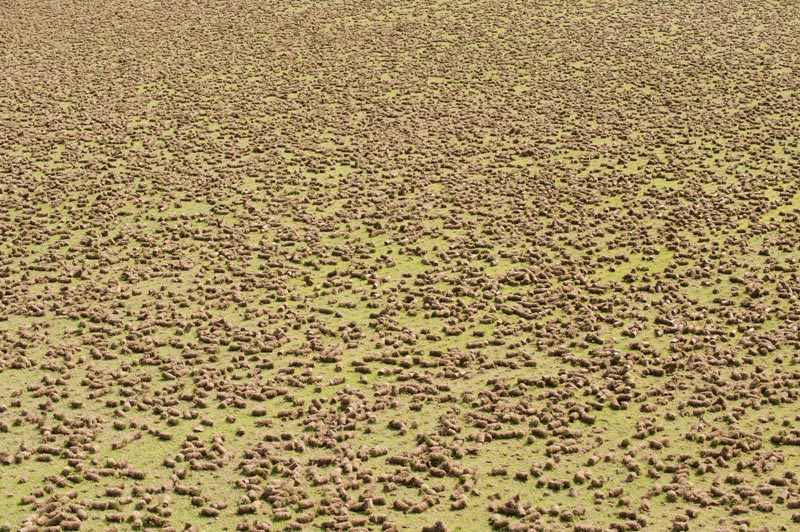
The 12-month growing season at Audubon Country Club in Naples, Fla., means pulling cores is a given in summer for Kenyon Kyle, CGCS. Photo by Montana Pritchard
“Anything to keep that hole open for a longer time,” says Kyle, a 24-year GCSAA member. “I’ve seen a benefit in percolation and air/gas exchange. They’re similar to the quadratines that we used 20 years ago — they were quarter-inch in diameter. That process sort of went by the wayside when HydroJect came in. Then that sort of went away, and people moved back toward venting with solid needle tines. Ninjas are similar — tiny little guys that still pull a core and are not disruptive to play.
“If you needle-tine, you’re just poking holes. Ninjas are very small, but if you pull a core in conjunction with topdressing, that hole better allows water infiltration and gas exchange, and it stays open a bit longer. As with the needles, other than a little sand, golfers don’t notice it much.”
Audubon CC revealed newly rebuilt greens in 2018. At the same time, Kyle installed a drainage system equipped with Precision Air blowers that can circulate air through the drainage system, thus achieving a level of air/gas exchange without any core aerification whatsoever.
“I tend to use this system more in the winter, when we get a cold night like we did in January, when I had soil temps of 42 degrees,” he says. “When we have very cold mornings, I will use the blowers later in the day, after the temperatures have increased, to pump warm air into the soil profile of our most challenging greens and increase the soil temperatures.
“It’s important to get the gas exchange somehow. The blowers help dramatically. You also get it with the deep-tine machine. You get that kick, which shatters the soil profile, creating cracks for oxygen and water to move through. There are several ways to accomplish this.
“Some superintendents have tried to get away from core aerification altogether, I’m not sure how successfully,” Kyle says. “Organic matter is going to build up eventually. At some very high-end clubs down here, where they don’t want any disruption, I hear they just let it ride and rebuild the greens every eight to 10 years. To me, that’s like saying I don’t have time to change the oil in my car, so I’m just going to go until it blows up, then buy a new car.”
Hal Phillips is the managing director of Mandarin Media, an international digital/content marketing firm. He is the former editor of Golf Course News.